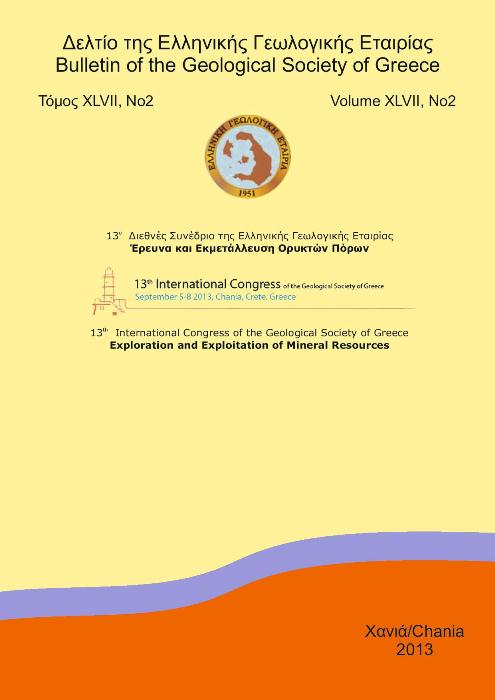MlNERALOGICAL STUDY AND PROPERTIES OF MAGNESIA REFRACTORIES DERIVED FROM EVIAN MAGNESITE
Περίληψη
In order for the Greek magnesia industry to retain a high position in the world market, the basic refractories derived from Greek magnesite must remain at the forefront of the international developments. A mineralogical study of magnesia materials produced from Evian magnesite has been carried out with the aim a) to provide detailed characterization of products and microstructures derived from the firing processes of magnesia raw materials and b) to contribute to the development of new magnesia-spinel refractory materials from natural Greek magnesite. The magnesite of N. Evia, Greece, is micro- crystalline and has been used for the production of basic refractories because of the very low amounts of impurities such as CaO, S1O2, FeO(tot), B2O3 it contains . Magnesia materials studied here are: 1) Raw materials. The dead- burned magnesia grains examined are divided into two groups according to the mode of beneficiation of the raw magnesite: a) Dead burned magnesias produced from natural microcrystalline magnesite (Group A). b) Dead burned magnesias of high purity produced from natural microcrystalline magnesite (Group B). The chemical composition of these materials lies essentially in the MgO-CaO-SiC>2 system, since they contain only trace amounts of Fe2Û3 and AI2O3. Their microstructures vary widely in terms of proportions of direct MgO-MgO bonding, amounts and types of phases of the siliceous bonding and size of the periclase crystals. Dead burned magnesias of high purity are better sintered and contain lower amounts of secondary phases compared to magnesias of lower purity. 2) Commercial magnesia bricks derived from dead burned magnesia of high purity and magnesia chromite bricks derived from raw materials of dead burned magnesia of high purity and chromite from Africa. 3) New spinel-based composition and new magnesia-spinel refractory materials which have been synthesized for the needs of this study. The newly synthesized spinel-based composition (70wt% Al2O3-30wt% MgO) shows an increase in the bulk density as well as in the amount of spinel formed compared to available commercial qualities (50%wt AI2O3). 4) Using this new spinel-based composition and dead burned magnesia of high purity, two new magnesia-spinel refractory materials containing 10 and 20wt% AI2O3 were produced, with the aim to obtain more friendly to the environment magnesia refractories to substitute for the magnesia chromite bricks. The compositions of the magnesia spinel refractories thus produced were expected to show endurance in thermal shocks as well as in the corrosion from slags and friction, in order to have a wide application in steel, cement industry etc .
Λεπτομέρειες άρθρου
- Πώς να δημιουργήσετε Αναφορές
-
Lampropoulou, P., & Katagas, C. (2004). MlNERALOGICAL STUDY AND PROPERTIES OF MAGNESIA REFRACTORIES DERIVED FROM EVIAN MAGNESITE. Δελτίο της Ελληνικής Γεωλογικής Εταιρείας, 36(1), 97–102. https://doi.org/10.12681/bgsg.16585
- Ενότητα
- Βιομηχανικά Ορυκτά και Πετρώματα

Αυτή η εργασία είναι αδειοδοτημένη υπό το CC Αναφορά Δημιουργού – Μη Εμπορική Χρήση 4.0.
Οι συγγραφείς θα πρέπει να είναι σύμφωνοι με τα παρακάτω: Οι συγγραφείς των άρθρων που δημοσιεύονται στο περιοδικό διατηρούν τα δικαιώματα πνευματικής ιδιοκτησίας επί των άρθρων τους, δίνοντας στο περιοδικό το δικαίωμα της πρώτης δημοσίευσης. Άρθρα που δημοσιεύονται στο περιοδικό διατίθενται με άδεια Creative Commons 4.0 Non Commercial και σύμφωνα με την οποία μπορούν να χρησιμοποιούνται ελεύθερα, με αναφορά στο/στη συγγραφέα και στην πρώτη δημοσίευση για μη κερδοσκοπικούς σκοπούς. Οι συγγραφείς μπορούν να: Μοιραστούν — αντιγράψουν και αναδιανέμουν το υλικό με κάθε μέσο και τρόπο, Προσαρμόσουν — αναμείξουν, τροποποιήσουν και δημιουργήσουν πάνω στο υλικό.






